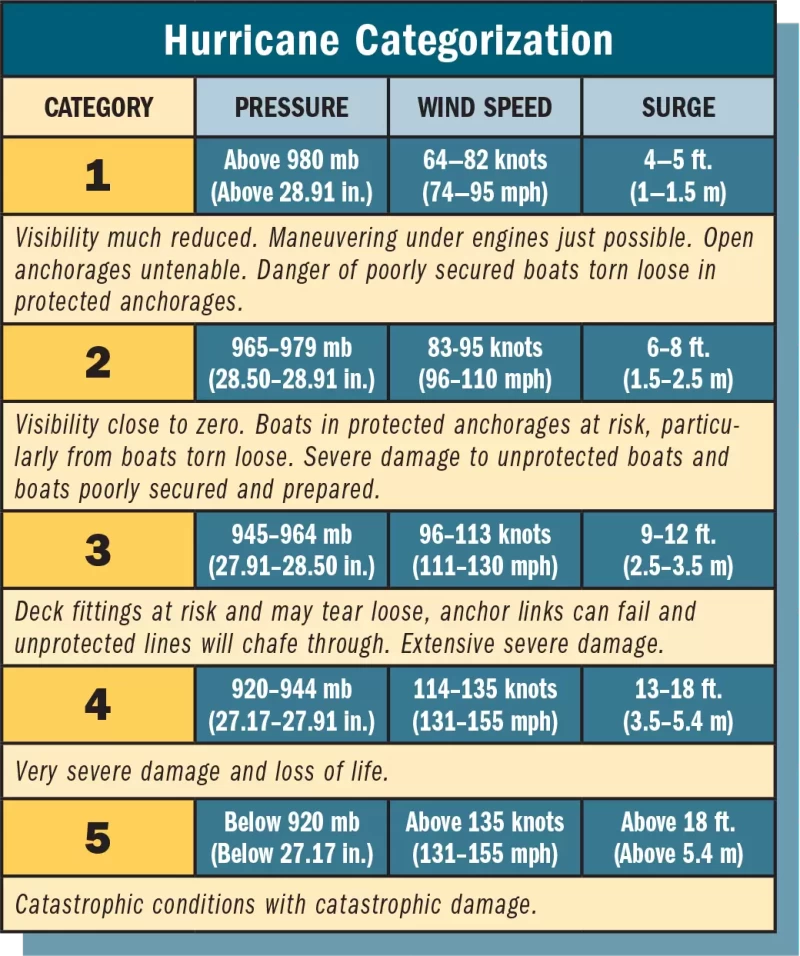While all coastal areas of the country are vulnerable to the effects of a hurricane (especially from June through November), the Gulf Coast, Southern and Mid-Atlantic states typically have been the hardest hit. But northern locales aren't immune; several destructive hurricanes have dealt a blow to areas in New England over the last 100 years including Hurricane Sandy in 2012 and Matthew in 2016. While hurricanes can create vast swaths of devastation, ample preparation can help increase your boat's chances of surviving the storm.
According to the National Weather Service, a mature hurricane may be 10 miles high with a great spiral several hundred miles in diameter. Winds are often well above the 74 mph required to classify as hurricane strength, especially during gusts. Hurricane damage is produced by four elements: tidal surge, wind, wave action and rain.
- Tidal surge is an increase in ocean depth prior to the storm. This effect, amplified in coastal areas, may cause tidal heights in excess of 15 to 20 feet above normal. Additionally, hurricanes can produce a significant negative tidal effect as water rushes out of the waterways after a storm.
- Wind gusts can exceed reported sustained winds by 25 to 50 percent. So, for example, a storm with winds of 150 mph might have gusts of more than 200 mph, according to the National Weather Service.
- Wave action is usually the most damaging element of a hurricane for boaters. The wind speed, water depth and the amount of open water determine the amount of wave action created. Storm surges can transform narrow bodies of water into larger, deeper waters capable of generating extreme wave action.
- Rainfall varies but hurricanes can generate anywhere from 5 to 20 inches or more of rain.

Slip Safety, Relocation, and Insurance Considerations
If your boat is in a slip, you have three options: Leave it where it is (if it is in a safe place); move it to a refuge area; or haul it and put it on a trailer or cradle. Some marinas require mandatory evacuations during hurricane alerts. Check your lease agreement and talk to your dockmaster before a hurricane if you are uncertain. Keep in mind that many municipalities close public mooring fields in advance of the storm. In some localities, boaters may be held liable for any damage that their boat inflicts to marina piers or property; check locally for details. Because of this, rivers, canals, coves and other areas away from large stretches of open water are best selected as refuges.
Consult your insurance agent if you have questions about coverage. Many insurance agencies have restricted or canceled policies for boats that travel or are berthed in certain hurricane-prone areas. Review your policy and check your coverage as many insurance companies will not cover boats in hurricane-prone areas during the June through November hurricane season. Riders for this type of coverage are notoriously expensive.
Preparing Your Boat
- Have a hurricane plan made up ahead of time to maximize what you can get done in the amount of time you will have to prepare (no more than 12 hours in some cases). Plan how to tie up the boat or where to anchor before a hurricane is barreling down on you. Make these decisions in advance!
- Buy hurricane gear well in advance. When word of a hurricane spreads, local ship stores run out of storm supplies (anchors and line, especially) very quickly.
- Strip everything that isn't bolted down off the deck of the boat (e.g., canvas, sails, antennas, bimini tops, dodgers, dinghies, dinghy motors, cushions, unneeded control lines on sailboats) as this will help reduce windage and damage to your boat. Remove electronics and valuables and move them ashore.
- Any potentially leaky ports or hatches should be taped up. Dorades (cowls) should be removed and sealed with deck caps.
- Make sure all systems on board are in tip-top shape in case you have to move quickly. Fuel and water tanks should be filled, bilge pumps should be in top operating condition and batteries should be fully charged
- You will need many lengths of line to secure the boat; make certain it is good stretchy nylon (not Dacron). It is not unusual to string 600 to 800 feet of dock line on a 40-foot-long boat in preparation for a hurricane. If you can, double up your lines (two for each cleat) as lines can break during a strong storm. Have fenders and fender boards out and make sure all of your lines are protected from chafing.
- If you are anchored out, use multiple large anchors; there is no such thing as an anchor that is too large. If you can, tie to trees with a good root system such as mangroves or live oaks. Mangroves are particularly good because their canopy can have a cushioning effect. Be sure mooring lines include ample scope to compensate for tides 10 to 20 feet above normal.
- Lastly, do not stay aboard to weather out the storm. Many people have been seriously injured (or worse) trying to save their boats during a hurricane. Take photos of the condition in which you left your boat and take your insurance papers with you.
Returning Safely After the Storm
- Before hitting the road, make sure the roads back to your boat are open and safe for travel. Beware of dangling wires, weakened docks, bulkheads, bridges and other structures.
- Check your boat thoroughly before attempting to move it. If returning to your home slip, watch the waters for debris and obstructions. Navigate carefully as markers may be misplaced or missing.
- If your boat should sink, arrange for engine repairs before floating it but only if it is not impeding traffic. Otherwise, you will need to remove it immediately. Contact your insurance company right away to make a claim.
Additional Resources












